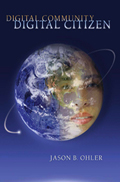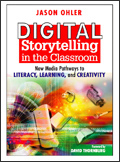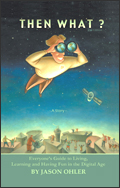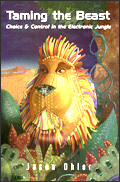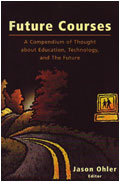The most recent column: What's Next in Ed Tech? Becoming Your Favorite Philosopher
See all columns
====
WEB 3.0 Watch
What drives Web 3.0, the "semantic" web?
One thing is our intense need to deal with info overload and the cognitive dissonance it causes. Web 3.0 does so by analyzing the information for us and presenting it in a way that is relevant to each of us personally.
Consider your average Google Search. Say you are searching for information on "global warming" ... let's compare and contrast Web 2.0 and Web 3.0 responses...
Web 2.0 yields: thousands of web hits, leaving you to paw through them, determine their reliability, reconcile their inconsistencies, figure out what to do next.
 Even if you have the tools to do these things, who's got the time? Be honest- do you ever look beyond the first 20 to 30 hits you get in a Google search? May the buyer beware.
Even if you have the tools to do these things, who's got the time? Be honest- do you ever look beyond the first 20 to 30 hits you get in a Google search? May the buyer beware.Web 3.0 yields: a single report or story, perhaps wikish, that synthesizes the thousands of hits, compares and contrasts them and identifies possible ways to resolve inconsistencies. The raw material of the report will include not only web material, but also a number of info sources plugged into the web, including book chapters, lectures on YouTube, Second Life events, TV shows, information stored on your personal computer, PowerPoint presos, to name but a few.
Web 3.0 knows a lot about you. And because it does, it will tell you about the following:
- blogs, discussion groups even paid experts and vendors who can shed more light on global warming or offer tools to help you in your quest
- assessment of where political candidates stand on issues related to global warming
- lectures, experts and TV programming available to you locally
- how you can play a role in your community to address global warming that is very community specific, drawing on services like Google Earth and local news
- local groups and individuals who are interested global warming and how to reach them
- stores in your area that feature earth friendly products
- information feeds that will constantly update your report
- and lots more
Who will control the world? Revisionist history will be created by whoever writes the code, and whoever pays them to do so. We will trust our Web 3.0 reports because we have to. Because we will not have time not to. They will become the truth, when actually they embody only one story about our world that has been told to us from a perspective we prescribed. Media mediating.
Web 3.0 is PIMC:

- Personal (connected in a just-for-you kind of way to the communities you are or could be part of)
- Intelligent (self-referential, self-synthesizing, self-organizing)
- Multimodal (using many kinds of media, appealing to many ways of learning, allowing for many kinds of access, input and output)
- Comprehensive (drawing on the entire universe of information, which it continually updates)
----------------

A real picture?
I don't know. I don't even know if this is astronomically possible. But by god it's gorgeous.
Click pic to enlarge.
---------
TECHST MESSAGES... news bits from the tEcosystem...

Quotables
"Wisdom is turning hindsight into foresight."
Discover more quotables
--- -- ---
My current favorite cool Web 2.1 tool?
Voice Thread. It allows you to create a slide show or story, and add your voice and annotation. Immensely easy to use, fun and useful.
What's web 2.1? Web 2.0 + art the 4th R. It is web 2.0 plus the integration of non-text information (pics, music, animation, et al) as an integral part of message conveyance, rather than an afterthought.
--- -- ---
Neologisms
- screasel. Screen + easel = screasel. It is the primary digital tool or locus of creativity for creating anything in the digital age, including images, music composition, dance animation...whatever. Screens became screasels when they went from read-only (first 50 years of TV) to write-possible (computers, cell phones, et. al.) Example: "Kids see screens as communication monitors as well as easels upon and through which to create original work of all kinds. They see them as screasels."
- wikish. Of or relating to a wiki. Also, anything that is an open, evolving, cumulative compendium of thought that is subject to on-going modification. "Our approach to product development was wikish in that all ideas were important and became part of our vision for the future that could change and be reconceived at any moment." Non-wikish? Anything fixed and hierarchical.
 Screasels - they're everywhere.
Screasels - they're everywhere. In this pic, a couple is watching a movie (screasel 1) of a group of children watching a girl on TV (screasel 2) who is using a cell phone and a computer (screasels 3 and 4).
Click pic to enlarge.
How many screasels do you have in your life?
--- -- ---
Nielson and Digimarc team up to track Net content
The Nielsen Co. and digital rights management company Digimarc Corp. are launching a new service that will monitor and manage media content across the Web, enabling media companies to track their content throughout the Internet using digital watermarking and fingerprinting technology.
In addition, it will allow content companies, peer-to-peer services, social networks and user generated content sites to manage and monetize online media streams.
Bottom line: they will watch everything we do, and feed it back to us in the form of highly personalized market pitches.
Read more
--- -- ---
Virtual writers picket virtual NBC in Second Life
It had to happen. Imagine a family reunion in Second Life. Or parent teacher conferences. Or a blind date. Or just about anything.
Read more
--- -- ---
Man creates life-size medieval village underneath his house
I wish I thought of doing that. But who's got the time?
A 57-year-old former insurance broker from northern Italy apparently had the time. Inspired by a childhood vision, he created a medieval village underneath his house that occupies 300,000 cubic feet and includes nine opulent ornate temples on five levels that are linked by hundreds of meters of richly decorated tunnels. It certainly wins the subTechst "basement of the month" prize.
Cyberhoax or reality wonder? If the latter, then it just goes to show that not all the really cool stuff in the world is digital.
Read more
--- -- ---
Smart Badges track human behavior
MIT researchers used conference badges to collect data on people's interactions and visualize the social network. Imagine having these at a party. Or a business negotiation. Or a trial. TMI? Not if you want to win.
Remember- eventually all information we collect feeds into Web 3.0, including info from smart badges. Are we sure we are okay with that? (Does it matter if we're not?)
Read more
--- -- ---
NASA seeks to build a MMOLG
(MMOLG stands for Massively Multiplayer Online Learning Game, though you probably knew that already).
NASA wants to use it to deliver NASA relevant content through innovative applications of technologies to enhance education in the areas of Science, Technology, Engineering, and Mathematics (STEM).
NASA obviously isn't playing around about games.
Read more
--- -- ---
New high level group seeks to understand digital kids
Former Federal Communications Commission chairman Michael Powell has a new job: digital hygienist. He wants a federal task force to study the impact of digital technology on kids. It actually looks promising, but we can be sure it will help not just parents and educators, but also marketers and everyone else who wants to understand the young consumer mind.
Read about it, then write your congressperson. Or email them, blog them, or send them a YouTube link to you ranting about it. A piece of advice: don't sing.
Read more
--- -- ---
A truly ingenious marketing move
Motion captures audience because we naturally watch what moves. How else do we know how the story ends?
This is a truly unique approach to engaging users in your website. Consider this version 1.0 of a concept that will certainly evolve.
Watch
--- -- ---
Top ten tech flops
At the top of the list? Toto Toilets, with heated seats that caught on fire. Use your imagination, but don't tell me about it.
Read more
--- -- ---
MacArthur Foundation's digital learning study
The MacArthur Foundation launched a five-year, $50 million digital media and learning initiative in 2006 to help determine how digital technologies are changing the way young people learn, play, socialize, and participate in civic life.
As always, MacArthur is "enlightening" the way.
Read more
--- -- ---
Wikis and avatars are improving education
So says this U.S. News and World Report article.
Read more
--- -- ---
The most influential media writing of 2007
According to John Bracken's readers.
Read more
--- -- ---
Top ideas of 2007
According to the New York Times.
Read more
--- -- ---
In some classrooms, IMming is an assignment
Many teachers who catch students instant messaging during class tell them to stop and finish their assignments. But in some classrooms, instant messaging is the assignment, as educators use the medium to teach everything from recognizing colloquialisms to writing for a particular audience.
Read more
--- -- ---
Second Life traveling tips
Second Life on less than 5 Linden a day, as well as a wonderful compendium of esoteric and solid advice for traveling in Second Life.
Read more
--- -- ---
The future of marketing? Getting to know you inside and out
The ability of new media to monitor what consumers are doing — like keeping track of which Web sites they visit — is fueling the interest in behavioral targeting.
Read more
--- -- ---

